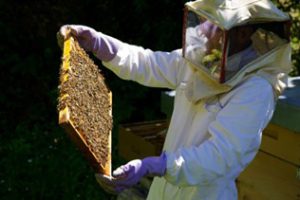 Small-Scale Beekeepers Earn More With Best Management Practices
Small-Scale Beekeepers Earn More With Best Management Practices
By Andrew Porterfield

A first-of-its-kind study examining the financial outcomes of small-scale beekeepers shows that following a set of best management practices can result in higher earnings—largely due to improved colony health via more active Varroa mite management. (Photo by mbeo via Flickr, CC BY-NC-ND 2.0)
While most of the honey produced by the European honey bee (Apis mellifera) industry comes from large, commercial beekeepers, small-scale beekeepers make up more than 90 percent of the number of keepers in the United States.
Small-scale beekeepers (those managing 50 colonies or less) are usually more interested in managing bees as a hobby, but they remain an important part of the $15 billion honey bee management industry in the U.S. They also suffer more economic consequences of hive losses than do commercial keepers. During the winter of 2021-2022, for example, small-scale keepers lost 58.5 percent of their hives, versus a 36.6 percent loss for commercial beekeepers. (Some losses over winter are expected for all honey bees.)
While the economics of commercial beekeepers are fairly well known, not much is known about the financial situation of small-scale keepers. While many hobbyist keepers may not be highly concerned about profits and losses from their activities, many other such keepers do sell honey and aim for some financial gain. To determine whether certain management practices may benefit small-scale keepers, a team from the University of Maryland and Washington State University conducted a financial analysis of small-scale beekeepers. Their results—the first covering the economics of small-scale beekeeping—were published in November in the Journal of Economic Entomology.
Bee colony losses can arise from a number of stresses, including parasites, pathogens, pesticides and inadequate nutrition. However, good management practices can reduce the impact of these stresses. The research team compared the revenue, cost, and profitability of small-scale beekeepers following two standards of practice:
- Average management practices (AMP) include removing and storing equipment from dead colonies for the following spring, applying miticides to control Varroa mites every fall, starting new colonies by purchasing packages of bees, and not treating old brood honeycombs before using them in a new colony.
- Best management practices (BMP) include reusing equipment immediately with a new colony or adding to an existing one, monitoring Varroa monthly and using miticide when needed, starting new colonies by splitting from successful colonies, and freezing honeycombs at −20 degrees Celsius for 24 hours before using them in a new colony.
The team looked at seven apiaries of 20 colonies, 10 under BMP and 10 under AMP for three years. They used economic tools of net present value and internal rates of return to determine what economic benefits BMP may provide.
They found that costs per colony under BMP were higher than AMP during the first two years, with an average cost of $219.55 per apiary for BMP versus $183.96 for AMP in the first year, for example. However, per-colony costs decreased more for BMP apiaries than for AMP (14.2 percent compared to 4.0 percent), largely because of reduced needs for BMP apiaries to replace dead colonies.
On the revenue side, the team found that under BMP, the amount of honey and number of colonies produced increased steadily. For BMP, average total revenue per colony increased 11 times over three years, versus 6.7 times in AMP colonies. By calculating net present value and internal rates of return, the researchers found that after three years, BMP apiaries were eight times more profitable than AMP apiaries. This was largely due to improved colony health brought about from better Varroa management.
There’s still room for improvement among BMP managed hives, the researchers write. Reducing labor costs from more experienced and streamlined management could boost profits, and simplifying Varroa monitoring and adjusting the timing of colony inspections and Varroa mite treatments could also boost the bottom line.
But further challenges remain even under BMP, and further, says Kelly Kulhanek, Ph.D., assistant professor in entomology at Washington State University and co-author on the study.
“Ultimately many of the factors making beekeeping difficult are outside the scope of what beekeepers can control,” Kulhanek says. “Even after three years of using BMPs, we still had colony losses around 30 percent. This is because, even with great management practices, honey bees are still subject to several interacting environmental stressors that contribute to their poor health.”
She adds, “Stressors like chronic low-level pesticide exposure and lack of floral resources in the landscape will always have some effect, no matter how well a beekeeper manages their hives. I think that ultimate bee health will only be achieved when we address these landscape level issues, which will require cooperation among many different stakeholder groups.”
We are here to share current happenings in the bee industry. Bee Culture gathers and shares articles published by outside sources. For more information about this specific article, please visit the original publish source: Small-Scale Beekeepers Earn More With Best Management Practices (entomologytoday.org)








